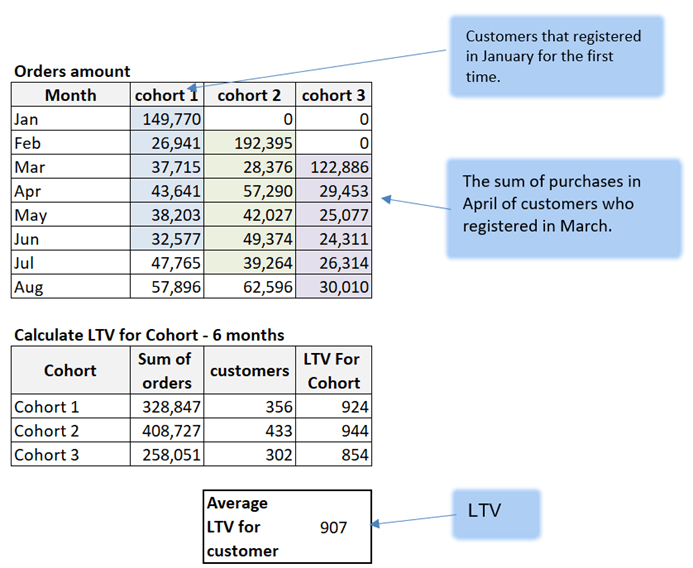For data analyst freelance services contact me [email protected]
What is LTV
Customer Lifetime value (LTV) is a metric that allows companies to estimate the average amount of money a customer will bring to the company. Although the metric is usually referred to as Lifetime value, it actually refers to the average revenue per customer over a year and it is also possible to calculate the metric for a shorter time period.
What is the use of the LTV metric?
The main use of the metric is in marketing and comparing the profitability of investing in different customer segments and acquisition channels. For example, if the average cost of acquiring a customer from Sweden is $50 and the estimated revenue from an average customer from Sweden is $1,000, then the investment in acquiring customers from Sweden would be profitable and it would be worthwhile to invest more marketing efforts in attracting customers from Sweden. Similarly, the LTV originating from paid promotion on Google can be calculated and compared to advertising on social media networks.
In addition, identifying the segments with a high LTV can help the growth and marketing teams to choose segments with the highest return on investment (ROI).
There are many ways to calculate the LTV metric. In this article, we will discuss two of the common methods.
Calculating customers LTV by Cohorts
Calculating LTV by Cohorts involves dividing customers into groups called Cohorts. Each Cohort is classified according to the month in which the customer joined. That is, customers who joined the product (or made their first purchase) in January will be in the first Cohort, customers who joined in February will be in the second Cohort, and so on.
For each Cohort, the average purchase amount for the selected time frame (in the example below, the time frame is half a year) is calculated.
After calculating the average for each Cohort, the average of all the Cohort averages is calculated, and this number represents the LTV metric.

Advantages of calculating customers LTV by Cohorts
The Cohort method is relatively easy to calculate and does not require additional knowledge about customer characteristics.
Since we calculate the average of a number of cohorts, we can reduce the impact of a group of customers who behave differently (confounding variables). For example, a group of customers who signed up in January due to a campaign promising large discounts may purchase products differently from customers who did not sign up through that campaign.
Calculating using this method also allows for calculating the percentage of customers who have churned.
Disadvantages of calculating customers LTV by Cohorts
This method does not provide a personalized prediction for each customer. It is not possible to predict the LTV for a specific customer, only to predict the LTV for all customers in the segment.
Personalized customers LTV prediction
In the Cohorts method, we estimated the average LTV of a group of customers. In the personalized prediction method, it is possible to predict the LTV of a specific customer by examining their characteristics.
LTV prediction in this method will be performed by statistical prediction models (such as regression or neural networks) that will use customer characteristics. For example: the number of times the customer visited the site, preferred products, their device type, geographic location, and more. Any information available about the customer can be fitted to the model.
Advantages of Personalized customers LTV prediction
- It is possible to predict the LTV of a specific customer and make sure to retain customers with high LTV.
Disadvantages of Personalized customers LTV prediction
- Calculating the LTV using this method is complex and requires extensive research and development of a reliable model.
- Even after extensive efforts, it is sometimes not possible to predict the LTV reliably since humans are variable creatures with changing desires, and it is truly difficult to predict their actions.
Remarks
- The time frame for calculating the LTV metric can be determined according to the business model. In a specific model, it may be advisable to predict the LTV of a customer for only six months or two months and not for a whole year.
- Calculating the LTV does not have to be based solely on customer revenue; LTV can also be calculated based on other metrics such as the average number of times a customer is exposed to an advertising campaign.
This article was written by Yuval Marnin.
If you have a need to hire a freelancer data analyst you may contact me at: [email protected]
You may also hire me through upwork platform on that link:
https://www.upwork.com/freelancers/~018940225ce48244f0\
More articles on Yam Analytics blog
The advantage of hiring a freelance data analyst.
What does a data analyst is doing and how it can help your company.





